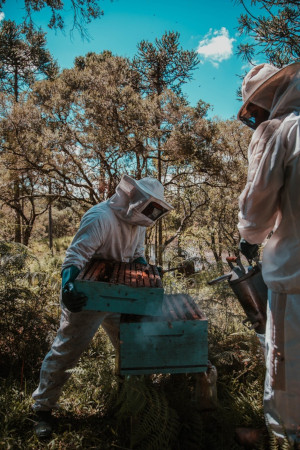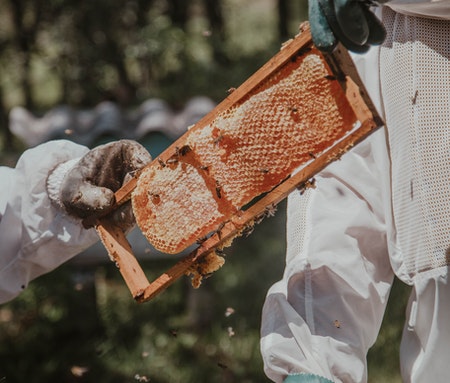Spring Control
The first spring control of colonies
It is not possible to determine exactly when the first detailed spring inspection of bee colonies should be performed, it depends primarily on climatic conditions. The most important thing is that the outside air temperature is above 18 Celsius degrees, and that the day when the first spring inspection will be performed is sunny, quiet, without wind.
If bee colonies entered the winter with a young and fertile queen, with a lot of young worker bees made in the first decade of the eighth month, until winter, and with a lot of quality reserve food, some experienced beekeepers with a large number of hives do not perform the first detailed inspection in the usual way. According to the behavior of worker bees when they fly out and enter the hive, and on the basis of a cursory inspection, they assess the condition of the hive.

However, regardless of the fact that the bee colonies are disturbed during the detailed inspection, we recommend that after the wintering, when the weather conditions allow it, it is obligatory to inspect each hive in detail. This is the safest way to determine the true state of society, which is necessary to take measures for their faster development, ie preparation for the successful use of the first main pasture.
You should thoroughly prepare for this inspection of bee colonies, so that during the inspection there is no downtime, to do everything correctly, calmly, but also quickly enough, because any delay can lead to unwanted consequences, for example, the appearance of looting, colds, damage queen and similar.
The first spring inspection of colonies should be done in calm weather, when the temperature is above 18 Celsius degrees.
The inspection tools should be wiped and disinfected, and then put in the prepared box. Check that the smoker works well and prepare enough material for smoking.
We remind beekeepers that it is necessary to prepare a notebook in which all data on the found condition are entered immediately after the inspection, for each hive separately. Based on these data, after the inspection of all hives in the apiary, appropriate measures are taken for each hive separately.
The first spring inspection of bee colonies is, in fact, the most detailed inspection of the year, and its goal is:
- To determine how bee colonies overwintered
- Do they have a queen and what is the quality?
- What is the strength of the bee colony in terms of the number of worker bees, i.e. that not many worker bees died during the winter?
- Are there any diseases and pests and to what extent?
- Are the walls of the hive and honeycomb dirty with feces?
- Is there any reserve food and how much is it, how it is arranged in the hive, etc.
Before starting the inspection, the bee colony should be smoked through the entrance reducer with a light smoke, wait a minute or two, and then carefully open the hive. Then, from above, over the honeycomb, smoke the bees again with smoke, taking care that the smoker does not move close to the bees and that no too sharp movements are made with the smoker, to avoid sparks or hot smoke.
Some beekeepers do not know that excessive smoke harms bees, and in severe cases it can lead to damage and even death of the queen. That is why bees should be smoked as little as possible, only as much as is necessary to be able to work successfully. When the bees are smoked from above, wait a bit, then the inspection begins. It is carefully taken out frame by frame, inspected and put back in its place.
The quality of the queen and her presence is appreciated by the brood. If the worker nest is densely packed on a continuous surface and the brood cells are flat and closed, it indicates that the colony has a good quality queen and there is no bee brood disease. However, if the brood is streaked and arranged in an intermittent row, it suggests that the colony has a lower quality queen. If there is only drone brood in a hive, it also indicates a poorer quality queen. Moreover, if the brood is too variegated and there are more drone litters, it further confirms the queen's poorer quality. Lastly, if there is only drone litter in a hive and no worker brood, it is a sign that the colony has a fake queen or drone.
In early March, a stronger bee colony requires approximately 10 to 12 kilograms of reserve food. During the inspection, it's essential to clean any dirt from the hive, particularly the accumulated rot on the base. Since the rot contains a lot of wax from the wax covers on the base, it's necessary to sift the rot and melt part of the wax covers into wax. The remaining dirt should be burned or buried deeper.

Along with this inspection, it's necessary to rearrange the bee nest. Since a lot of food is consumed in the central part of the nest during winter and the number of worker bees is reduced, the space in the hive usually becomes large for a smaller number of bees. To ensure faster development of the bee colony, the nest should be narrowed, and the brood, bees, and food should be grouped into a smaller number of frames. Six to nine frames are usually grouped, sometimes more or less depending on the strength of the bee colony. Frames with brood should be placed in the central part of the nest, and next to them should be frames with a wreath of honey in the upper part, i.e. a honey cap, but with ample empty space on the honeycomb for the queen to lay eggs. Frames with a lot of honey and pollen powder should be placed next to these frames.
Such a narrowed bee nest should be re-warmed to prevent the consequences of possible cooling. This allows the bee colony to properly nurture, feed, and heat the bee brood, maintaining a constant temperature of 33-35 degrees Celsius in the brood area. Any deviation from this temperature adversely affects the development of the bee society as a whole.
Some beekeepers point out that this warming is more important than winter warming, because the brood develops abruptly during this time, and the differences between night and day temperatures are large. In addition, the weather conditions are very changeable, making it more likely to get colder. In colonies that are not properly warmed, an enlarged brood can cause colds, rot, and various diseases. If the warming material becomes damp during the winter, it should be replaced with fresh and dry material. When the inspection and rearrangement of the beehive is completed, the hive should be carefully closed.
At the end of the inspection of one hive, all the details of the found condition should be entered in the notebook, and in particular, the following:
- Does the colony have a queen and what is its quality? If there is a lot of brood in relation to other colonies and if the brood is compact, it means that the queen is good and vice versa;
- How strong is the colony, that is, how many worker bees are present
- How much food, honey, and pollen are in reserve
- What is the condition of the honeycomb, not only in terms of its age, but also whether it is moldy, how many honeycombs there are with drone cells, and how much it is damaged in any way, etc.
- Have any diseases or pests appeared
- If there is no queen, have false queens already appeared, etc.
All of these details, for each hive separately, should be transferred from the notebook to the main book after the inspection of all bee colonies. This is done in order to take the appropriate measures for each colony separately, immediately after the inspection.
arrow_upward